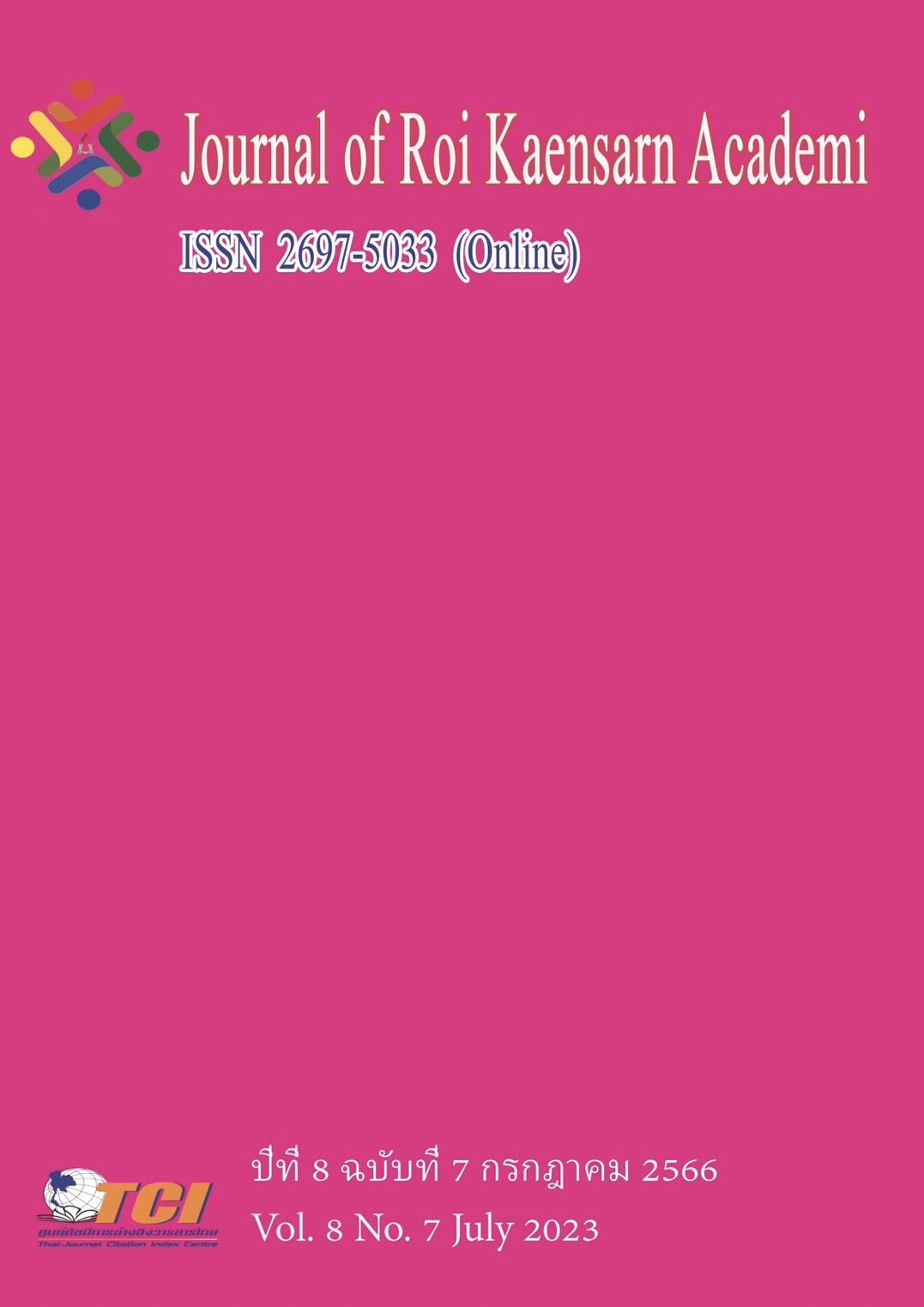An Analysis of Lexical Semantic Errors in English Writing by Thai EFL Learners
Main Article Content
บทคัดย่อ
This study examined the semantic lexical errors made by Thai undergraduate learners of English in their writing. A total of 462 writing tasks were analyzed, resulting in 1,256 errors, with an average of 2.72 semantic lexical errors per paper. The errors were classified into twenty categories based on James' (1989) lexical taxonomy. The most prevalent error was calque, accounting for 51.04% of total errors. The second highest number of errors was misselection of vowel-based forms, at 12.58%, closely followed by misselection of suffixes at 9.47%, preposition errors at 6.29%, and near synonyms at 3.98%. Notably, there were five categories of errors that did not occur at all, including overly specific terms, inappropriate co-hyponyms, arbitrary combinations, verbosity, and misselection of prefixes. The study found that calque errors, or errors resulting from direct translation from the learner's first language, were the most prevalent among Thai learners of English. These errors occur when Thai words are translated literally into English, without considering the subtle differences in meaning between the two languages. The study also found that Thai EFL writers often struggle with correctly adding suffixes to words, and that errors related to the use of preposition partners and semantic word selection were also prevalent. These error types, along with specific examples, were carefully examined and discussed in detail throughout the study.
Article Details
เอกสารอ้างอิง
Biber, D. (1990). Methodological issues regarding corpus-based analyses of linguistic variation. Literary and Linguistic Computing. 5 (4), 257-269.
Biber, D. (1993). Representativeness in corpus design. Literary and Linguistic Computing. 8 (4), 243-257.
Bruffee, K. (1986). Social construction, language, and the authority of knowledge: A bibliographic essay. College English. 48 (8), 773-790.
Canale, M., & Swain, M. (1980). Theoretical bases of communicative approaches to second language teaching and testing. Applied Linguistics. 1 (1), 1-47.
Corder, S. P. (1974). Error analysis. Oxford University Press.
Cope, B., & Kalantzis, M. (1993). The powers of literacy: A genre approach to teaching writing. London: Falmer Press.
Cumming, A. (2001). Writing expertise and second language proficiency. In R. Kaplan (Ed.), Oxford handbook of applied linguistics (666-675). Oxford University Press.
Durkin, D., Shire, B., & Beeman, M. (1985). What children know about prepositions. Cognitive Development, 1(3), 261-280.https://doi.org/10.1016/S0885-2014(85) 80006-4
Duskova, L. (1969). Error analysis and the teaching of English. East Lansing: Michigan State University Press.
Engber, C. A. (1995). Language learning strategies: Theory and perception. Prospect Heights, IL: Waveland Press.
Fairclough, N. (2001). Language and power. (2nd ed.). London: Longman.
Ferris, D. R., & Hedgcock, J. S. (2005). Teaching ESL composition: Purpose, process, and practice. Routledge.
Heo, J., & Prescott, J. (2021). Exploring the effects of linguistic and non-linguistic factors on L2 writing: A mixed-methods study. Journal of Second Language Writing. 51, 100854.
Iamsiu, C. (2014). The five most frequent errors caused by mother tongue interference in writing in English by Thai undergraduate students. International Journal of Language and Linguistics. 1 (4), 144-154.
Ivanic, R., & Camps, D. (2001). I am how I sound: Voice as self-representation in L2 writing. Journal of Second Language Writing. 10 (1-2), 3-33.
James, C. (1998). Errors in language learning and use: Exploring error analysis. Longman.
Keshavarz, M., & Atai, M. R. (2019). L1 transfer and prepositional errors in EFL learners' writing: The case of Iranian students. Iranian Journal of Language Teaching Research, 7 (1), 27-41.
Kleisar, J. (2005). Writing apprehension and academic procrastination among graduate students. Perceptual and Motor Skills. 101 (1), 167-172.
Laufer, B. (1989). What percentage of text-lexis is essential for comprehension? In C. Lauren & M. Nordman (Eds.), Special language: From humans thinking to thinking machines (316-323). Clevedon: Multilingual Matters.
Leech, G. (1981). Semantics: The study of meaning. Penguin Books.
Leisak, J. E. (1989). A comparison of L1 and L2 writing: Errors and expectations. In D. M.
Johnson & D. H. Roen (Eds.). Richness in writing: Empowering ESL students (141-151). Longman.
Liu, J., & Kunnan, A. J. (2016). Investigating second language writing: Issues and perspectives. New York: Routledge.
Lui, Y., & Xiang, P. (2018). An empirical study of semantic redundancy in Chinese EFL learners’ writing. Journal of English for Academic Purposes. 32, 28-41.
Matsuda, P. K. (2003). Second language writing in the composition classroom: A critical sourcebook. Boston: Bedford/St. Martin's.
Nation, P. (2011). Learning vocabulary in another language. Cambridge University Press.
Nunan, D. (1989). Designing tasks for the communicative classroom. Cambridge: Cambridge University Press.
Richards, J. C. (1971). A non-contrastive approach to error analysis. English Language Teaching Journal. 25 (3), 204-219.
Richards, J. C. (1976). The role of vocabulary teaching. TESOL Quarterly. 10 (1), 77-89.
Richards, J. C., & Schmidt, R. (2002). Longman dictionary of language teaching and applied linguistics. (3rd ed.). London: Pearson Education.
Richards, J. C., & Renandya, W. A. (2002). Methodology in language teaching: An anthology of current practice. Cambridge University Press.
Schmitt, N., & Zimmerman, C. B. (2002). Derivative word forms: What do learners know? TESOL Quarterly. 36 (2), 145-171.
Sermsook, K., Liamnimitr, P., & Pochakorn, P. (2017). An investigation of common errors in English writing made by Thai EFL university students. PASAA: Journal of Language Teaching and Learning in Thailand. 51, 79-100.
Suvarnamani, O. (2017). Errors in writing by Silpakorn University students: Causes and strategies. International Journal of Humanities and Social Science Research. 6 (1), 1-14.
Syarinpuddin, Y. (2015). Writing errors in English: A study of Thai EFL learners. The Southeast Asian Journal of English Language Studies. 21 (3), 139-153.
Thep-Ackrapong, T. (2005). Thai learners’ English writing problems: An analysis of Thai-English language interference. Journal of Language and Linguistics. 4 (2), 248-276.
Tian, M., & Zhao, Z. (2020). The impact of direct translation on Chinese EFL learners' use of idiomatic expressions in writing. Journal of Language Teaching and Research. 11 (6), 535-546.
Weigle, S. C. (2002). Assessing writing. Cambridge University Press.

